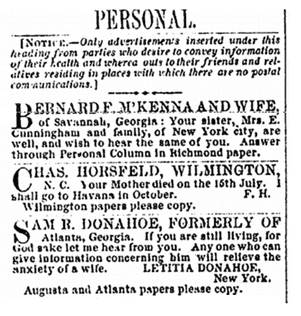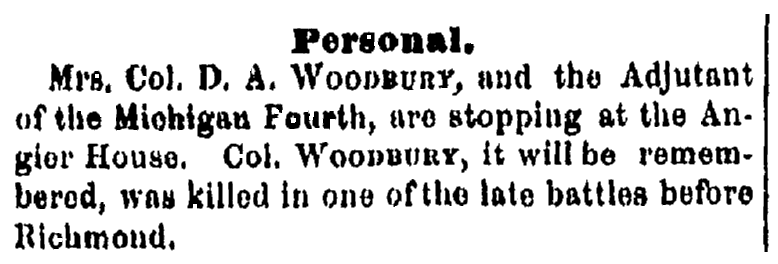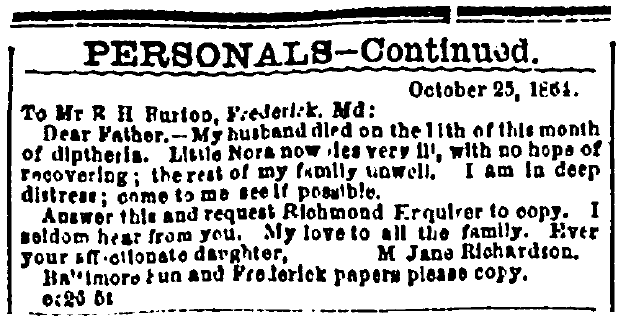Introduction: In this article, Mary Harrell-Sesniak shows that one of the ways ordinary citizens and families communicated across enemy lines during the Civil War was by having personal notices and even letters published in newspapers – and these are a great resource for family historians. Mary is a genealogist, author and editor with a strong technology background.
It’s often said that “Where there is a will, there is usually a way.” This is true even during the most challenging times – such as during the American Civil War, when in the midst of terrible fighting, communications still found their way across enemy lines. Families either smuggled letters, sent them via flags of truce, or – what is not often realized – published them in local newspapers.

Thanks to digitized newspaper collections online, such as GenealogyBank’s Historical Newspaper Archives, genealogists can search these old newspapers to find very personal communications from and about their ancestors.
Restricted Messages
Some newspapers during the Civil War, such as the Daily National Republican of Washington, D.C., limited the types of notices its readers could publish. In this old news article example, readers could only submit information regarding health or whereabouts to friends and relatives.
- E. Cunningham and family of New York City relayed a message to Mr. and Mrs. Bernard F. McKenna. They were well and wished to hear the same from them.
- Charles Horsfield of Wilmington, North Carolina, learned that his mother had died on the 15th of July, an important genealogical date if an obituary was not published.
- Letitia Donahue of New York City was desperate to hear news of her husband Sam. He was formerly of Atlanta, Georgia – but if you notice the reference to Augusta, this is an important clue as to his possible whereabouts.

“Please Copy” or Answer Instructions
Whenever you spot a “please copy” notice, there is a connection to the location. It may be a residence, place where someone works, or – in the case of a soldier – a place where they were stationed.
Many of these newspaper notices also gave instructions as to how one could answer. This clue indicates that they had access to a particular newspaper, even if they lived elsewhere.
Reprisals and Hidden Identities
One of the more proactive newspapers during the Civil War was the Richmond Enquirer in Virginia, which exchanged personals with various northern papers.
Divided families often printed notices – but if they feared reprisals, either for themselves or for loved ones, they would disguise identities by using nicknames or initials. In this example, E. S. C. requested to hear from Mrs. M. J. Ebbs. They were well and sent their love to Alice.

Search tips to locate hidden identities:
- Search without a surname
- Search by initials with or without a surname
- Search by nicknames and locations
Civil War Soldier News
Not surprisingly, many newspaper notices were about missing Civil War soldiers.
In the same issue of the Richmond Enquirer, there was a message to Lieut. J. M. Podgett of the 18th Georgia reporting that Britton W. Riggons was well and comfortable at Camp Douglas in Illinois.
Another notice, to Charles B. Linn, notes that messages were getting through and that “things” were sent back. He was welcome to respond to “W. S. R.” via the Richmond Enquirer or the New York News.

Letters to Congressmen
Many letters published in newspapers during the Civil War are full of pathos and desperation, such as the following example.

After learning that Dr. Frederick Griffith had been captured about the 20th of September, Wat H. Tyler, M.D., wrote his Congressman Joseph Segar.
What is exciting about this discovery is that the capture is reported in official records, but not how assistance was requested. Griffith was exchanged on 19 March 1865, most likely a direct result of Tyler’s letter. Be sure to visit their Findagrave memorials:
- Frederick Griffith: http://www.findagrave.com/cgi-bin/fg.cgi?page=gr&GRid=6945174
- Joseph Eggleston Segar: http://www.findagrave.com/cgi-bin/fg.cgi?page=gr&GRid=6862543
- Wat Henry Tyler, Jr. http://www.findagrave.com/cgi-bin/fg.cgi?page=gr&GRid=120187991
Civil War Vital Records
When you cannot locate a vital record from the Civil War era, a genealogist might find direct or indirect evidence of that record in newspaper notices. In this example, the widow was visiting the Angier House and her husband’s loss was noted.

This sad notice is important because it connects three generations, and substitutes for an obituary.
In this next example, M. Jane Richardson wrote her father to report that her husband had died on 1 October 1864 of diphtheria, and that Little Nora had no hope of recovering either. She was in deep distress and asked her father to come see her.

Civil War Marriage Records
What is wonderful for genealogists searching these Civil War-era newspapers is that not all notices were sad.
Many marriage notices were published at that time. In this one, G. L. M. married Miss A. L. on Wednesday, March 30, 1864, possibly in New York.
Genealogical Challenge: Try to figure out whom this marriage notice was about and let us know in the comments!

Civil War research is a fascinating topic – and it doesn’t have to be limited to official records.
You can date early photographs using revenue stamps, learn about regiments through their uniforms, and explore the fascinating articles and letters found in historical newspapers.
Related Civil War Articles & Resources:

I am trying to find out what the numbers and letters that frequently appear at the bottom of notices placed in Civil War era newspapers mean. They follow the date of the notice on the bottom line. Two of the examples you use above have them: Personals to Mr. R. H. Burton has “5t” and the letter to the Hon. Joseph Segar has what looks like 5b4 . Some of these number/letters are connected with ampersands such as “b1&d3&w4” What do these mean?
Hi Linda,
Thank you for your questions.
Occasionally old newspaper print reproduces incorrectly or picks up marks that distort the original.
As per your observations, the 5t indicates the advertisement would run five times. I don’t think those are ampersands. The one to Mr. Segar began October 25 and also ran 5 times. The mark between the 5 and the t may have been a plus or a cross.
Printers were often known to use individual styles.
Mary